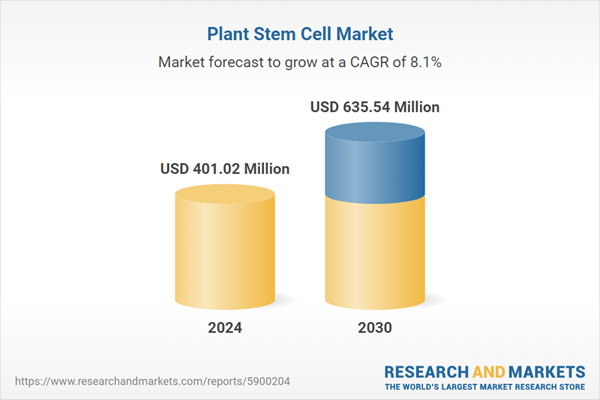Speak directly to the analyst to clarify any post sales queries you may have.
10% Free customizationThis report comes with 10% free customization, enabling you to add data that meets your specific business needs.
The Plant Stem Cell Market was valued at USD 401.02 Million in 2024 and is projected to reach USD 635.54 Million by 2030, rising at a CAGR of 8.12%. This market lies at the crossroads of biotechnology, healthcare, agriculture, and cosmetics, focusing on the use of stem cells derived from plants in applications ranging from skincare and nutraceuticals to pharmaceuticals and crop enhancement. Driven by the rising consumer preference for plant-based and sustainable products, coupled with significant biotechnological advancements, the industry is witnessing consistent growth. The expanding elderly population and growing awareness of anti-aging and regenerative solutions have particularly fueled demand in cosmetic and healthcare sectors. Furthermore, increasing investment in regenerative medicine, as seen in strategic collaborations such as the Wipro and Pandorum Technologies partnership in 2022, continues to spur innovation and expand the market’s potential across multiple verticals.
Key Market Drivers
Rising Demand for Natural and Organic Products
The increasing global preference for natural and organic ingredients has emerged as a critical driver of growth in the Plant Stem Cell Market. Consumers are becoming more health-conscious and environmentally aware, leading them to favor products with plant-based origins over synthetic alternatives. In the skincare and personal care industry, plant stem cells are valued for their antioxidant and rejuvenating properties, offering benefits such as anti-aging effects and skin repair. This consumer shift is especially significant in cosmetics and dermatology, where the appeal of chemical-free, safe, and effective formulations continues to boost demand. Additionally, the perception of plant-derived products as sustainable and ethically produced further strengthens their adoption across sectors like nutraceuticals and healthcare, thereby fostering market expansion.
Key Market Challenges
Regulatory Hurdles and Compliance Issues
Navigating the regulatory framework surrounding plant stem cell products presents a considerable challenge for market players. The absence of globally harmonized regulations leads to discrepancies in product approval procedures, labeling requirements, and classification standards across regions. This lack of standardization complicates product commercialization and increases compliance burdens, particularly for companies operating internationally. Additionally, concerns related to ethical sourcing, especially when rare or endangered plant species are used, pose further complications. Ensuring biodiversity conservation while maintaining a sustainable and scalable supply chain adds complexity to product development, affecting timelines and operational costs.
Key Market Trends
Growing Focus on Sustainable and Ethical Sourcing
Sustainability and ethical sourcing are becoming central to product development in the Plant Stem Cell Market. Manufacturers are prioritizing environmentally responsible extraction methods and sustainable cultivation practices to meet regulatory expectations and consumer demand for clean-label ingredients. There is also a trend toward utilizing renewable plant sources and ensuring traceability in the supply chain. With the increasing influence of eco-conscious consumers, companies that commit to transparency and sustainable innovation are likely to gain competitive advantages. Moreover, product certifications and green marketing are playing a key role in shaping purchase decisions, especially in the cosmetics and healthcare industries.
Key Players Profiled in this Plant Stem Cell Market Report
- Uniliver PLC
- Renature Skin Care Inc.
- PhytoScience Ltd.
- Oriflame Cosmetics AG
- MyChelle Dermaceuticals LLC
- Mibelle Group AG
- Juice Beauty LLC
- Emsland Group GmbH
- Bio-FD&C Co., Ltd.
- Aidan Products LLC
Report Scope:
In this report, the Global Plant Stem Cell Market has been segmented into the following categories, in addition to the industry trends which have also been detailed below:
Plant Stem Cell Market, by Location:
- Shoot Apical Meristems
- Root Apical Meristems
- Vascular Meristems
Plant Stem Cell Market, by Application:
- Nutrition
- Pharmaceutical
- Cosmetics
Plant Stem Cell Market, by Region:
- North America
- United States
- Canada
- Mexico
- Europe
- France
- United Kingdom
- Italy
- Germany
- Spain
- Asia-Pacific
- China
- India
- Japan
- Australia
- South Korea
- South America
- Brazil
- Argentina
- Colombia
- Middle East & Africa
- South Africa
- Saudi Arabia
- UAE
Competitive Landscape
Company Profiles: Detailed analysis of the major companies present in the Global Plant Stem Cell Market.
Available Customizations:
With the given market data, the publisher offers customizations according to a company's specific needs. The following customization options are available for the report.
Company Information
- Detailed analysis and profiling of additional market players (up to five).
This product will be delivered within 1-3 business days.
Table of Contents
Companies Mentioned
The leading companies profiled in this Plant Stem Cell market report include:- Uniliver PLC
- Renature Skin Care Inc.
- PhytoScience Ltd.
- Oriflame Cosmetics AG
- MyChelle Dermaceuticals LLC
- Mibelle Group AG
- Juice Beauty LLC
- Emsland Group GmbH
- Bio-FD&C Co., Ltd.
- Aidan Products LLC
Table Information
| Report Attribute | Details |
|---|---|
| No. of Pages | 190 |
| Published | May 2025 |
| Forecast Period | 2024 - 2030 |
| Estimated Market Value ( USD | $ 401.02 Million |
| Forecasted Market Value ( USD | $ 635.54 Million |
| Compound Annual Growth Rate | 8.1% |
| Regions Covered | Global |
| No. of Companies Mentioned | 11 |









